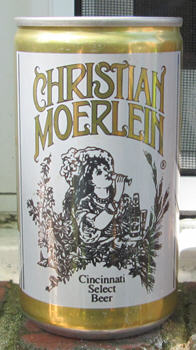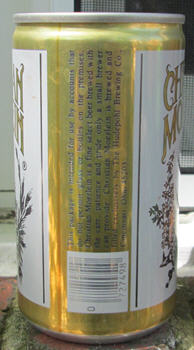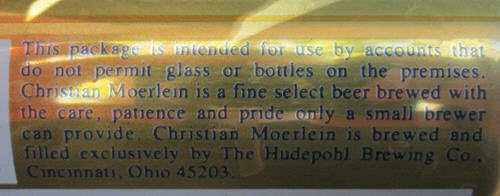Christian Moerlein: 1982
 |
 |
This month I am going back to Cincinnati and Hudepohl Brewing. And Hudepohl was itself going back to pre-prohibition Cincinnati to find the inspiration for this can.
Christian Moerlein
Christian Moerlein (1818-1897) was perhaps Cincinnati's most prominent brewer. A native of Bavaria, he immigrated to the US in 1841 and ended up in Cincinnati. He opened his own brewery in 1853 in Over-the-Rhine, the area that was the center of Cincinnati's German community. The brewery grew over the years, and Moerlein became one of the few national "shipping breweries" before Prohibition. That meant that he shipped his product all over the US, as did such breweries as Anheuser-Busch, Schlitz and Pabst. Only a small minority of US brewers shipped that widely. (I dug one of his brewery's bottles in central Maryland) Moerlein died in 1897 but his business continued until Ohio very reluctantly went dry in 1919. After Prohibition ended in 1933 the brewery was not reopened as Christian Moerlein, but the facility was used by the Old Munch Brewing company until 1937.
Hudepohl's Reboot
Numerous breweries opened in the Cincinnati area after Prohibition: Hudepohl, Burger, Red Top, Wiedemann, Bruckmann, Bavarian, Jackson, Schoenling, etc. Some, such as Hudepohl, existed before 1920, other, such as Schoenling, were new. But all of them found themselves losing market share in the 19409s and 1950s, pressed by the big nationals. Wiedemann was bought out by a national and continued producing its beer and others. Some like Red Top just closed. By 1981 Hudepohl and Schoenling were the only two breweries left in Cincinnati.
Hudepohl tried a number of different strategies to survive pressure from the big national brands. They remade their flagship brand, replacing Hudepohl 14K with a premium Hudepohl, and they began to put an ever greater emphasis on playing to hometown pride. They increased advertising on local TV and radio as well as in newspapers and magazines. They also introduced a "super premium" beer, Christian Moerlein, named, as I noted above, after a successful pre-prohibition Cincinnati brewer. By using Moerlein's name, Hudepohl hoped to capitalize on a well-regarded part of Cincinnati brewing history. they even used an original Christian Moerlein ad for their label.
Christian Moerlein beer was introduced in September 1981 after a four-month long teaser "coming soon" campaign. It was designed to compete with beers imported to the US from Europe, which were gaining in popularity at the time. Hudepohl's management felt that the nationals were abandoning that market niche, allowing small brewers to step in. In the words of General Manager and Vice-President Bob Pohl referring to Miller Brewing, "...they're trying to appeal to the blue-collar market. We're doing exactly the opposite."
The beer was an immediate success and Hudepohl had to work hard to try to keep up with demand. Sales were five times higher than projected, although the new brand still only made up less than 10% of the brewery's total output. The brand was sold only in Cincinnati at first, but eventually expanded to other parts of Hudepohl's market in Ohio and the surrounding states. It was not enough to keep the brewery going, and in 1986 they merged with Schoenling. In 1997 Hudepohl-Schoenling was sold to Boston Beer (Samuel Adams). After 1999 their brands were made in Frederick, maryland and LaCrosse, Wisconsin. (heresy!).
In 2004 Cincinnati resident Greg Hardman bought the rights to the Christian Moerlein brand name and began producing it again. He then acquired the rights to multiple of historic Cincinnati beer brands, including Hudepohl and Schoenling. The current Hudepohl-Schoenling Brewing Company is now a subsidiary of the Christian Moerlein Brewing Company. I wonder what Christian Moerlein and Ludwig Hudepohl would make of this. Hudepohl brought back Christian Moerlein and then Christian Moerlein brought back Hudepohl.
A Side Note
 |
I like the side panel because it's a bit of a throwback. "This package is intended for use by accounts that do not permit glass or bottles on the premises." (emphasis added). That echoes some of the old beer can ads from the 1930s and 1940s that emphasized how cans were more convenient than bottles. They were lighter and could be thrown away. Ads showed people taking cans on picnics or fishing trips, places where they worked better than "glass or bottles." In Europe, cans were often used to serve beer on trains or airplanes, places where draft beer was awkward to serve, and where bottles would take up too much room and weight. (Check the side panels on last month's COM to see an example).
Variations
There seem to be five variations of this can.
1. The one shown above is, I think, the first one.
2. The one shown above, but with a slightly different side text. The words are the same, but they are spaced a bit differently and the line breaks are different.
3. The gold design with "12 FL OZ .355 ML" along the bottom edge.
4. The gold design, but with a tapered top.
5. A different label with much more red in it.
I am still researching the variations and will update it as I learn more.
You can read about another Hudepohl brands on the following pages.
March 2010: Hudepohl and their low-alcohol Pace Beer.
February 2008: Hudepohl's 1975 and 1976 Cincinnati Reds Cans.
September 2016: Hudepohl J-spouts and crowntainers.
Sources Used
"Hobby News." Beer Cans Monthly. (July 1982). 15.
Holian, Timothy J. Over the Barrel: The Brewing History and Beer Culture of Cincinnati. Volume 2. Prohibition-2001. (Sudhaus, 2001)
"Small Brewers Turn to Specialty Beers." BCCA News Report. (March/April 1982). 32.
